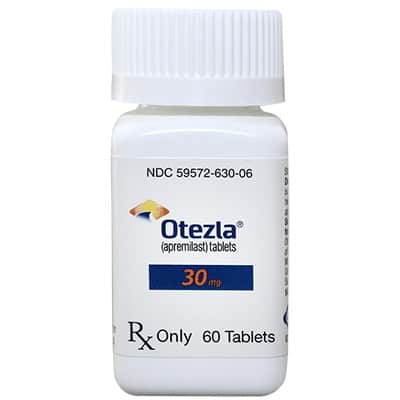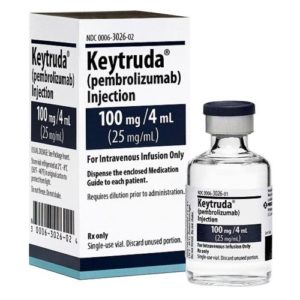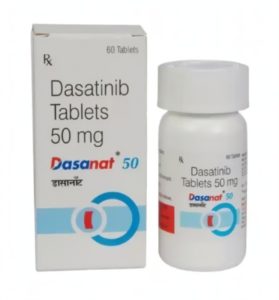Apremilast is approved for the treatment of adult patients who are suitable for phototherapy or systemic therapy and have active psoriatic arthritis or moderate to severe plaque psoriasis.
Indications of apremilast?
Apremilast was authorized by the FDA for the treatment of plaque psoriasis in the following indications:
- Individuals with a history of hepatitis B or C, demyelinating illness, malignancy, chronic infection (e.g. HIV), or congestive heart failure.
- Patients who have been on systemic corticosteroid medication for an extended period of time.
Apremilast mechanism of action
Although the exact mechanism of action of this medicine is unknown, it is known that apremilast is a phosphodiesterase 4 (PDE4) inhibitor, which is involved in the activity of cyclic adenosine monophosphate (cAMP), a second messenger. Apremilast’s suppression of PDE4 results in a rise in intracellular cAMP levels. By lowering the expression of TNF-, IL-17, IL-23, and other inflammatory mediators, an increase in cAMP suppresses inflammation.
The inflammatory mediators listed above have been implicated in a variety of psoriatic disorders, as well as Behcet’s illness, where they contribute to the development of unpleasant inflammatory symptoms such as mouth ulcers, skin lesions, and arthritis. Apremilast therapy initiates a cascade that finally results in a decrease in the levels of the aforementioned mediators, alleviating inflammatory symptoms.
Dosage
ADULT PEDIATRIC
Dosage Forms & Concentrations:
Tablet
- 10mg
- 20mg
- 30mg
Arthritis Psoriatica
Indicated in the treatment of active psoriatic arthritis
Day 1: 10 mg PO in the AM
Day 2: 10 mg PO in the morning and evening
Day 3: 10 mg PO in the morning and 20 mg PO in the evening
Day 4: 20 mg PO in the morning and evening
Day 5: 20 mg PO in the morning and 30 mg PO in the evening
Day 6 and subsequent days: 30 PO mg BID
Psoriasis plaque
Indicated for people who are candidates for phototherapy or systemic therapy and have plaque psoriasis of any severity.
Day 1: 10 mg PO in the AM
Day 2: 10 mg PO in the morning and evening
Day 3: 10 mg PO in the morning and 20 mg PO in the evening
Day 4: 20 mg PO in the morning and evening
Day 5: 20 mg PO in the morning and 30 mg PO in the evening
Day 6 and subsequent days: 30 mg PO BID
Oral Ulcers as a Symptom of Bechet Disease
Oral ulcers related to Bechet disease are indicated.
Day 1: 10 mg PO in the AM
Day 2: 10 mg PO in the morning and evening
Day 3: 10 mg PO in the morning and 20 mg PO in the evening
Day 4: 20 mg PO in the morning and evening
Day 5: 20 mg PO in the morning and 30 mg PO in the evening
Day 6 and subsequent days: 30 mg PO BID
Administration
Take this medication by mouth with or without food, generally twice daily, as advised by your doctor. The manufacturer advises against crushing, splitting, or chewing the tablet prior to use. Many comparable medications (immediate-release tablets) can, however, be crushed, divided, or chewed. Adhere to your doctor’s instructions regarding the proper way to take this medication.
Apremilast side effects
Apremilast’s most often reported adverse effects to include diarrhea, nausea, upper respiratory tract infection, and headache. After two weeks of treatment, the majority of patients who experienced diarrhea and nausea felt better without discontinuing treatment. Significant adverse effects include weight loss and depression. Inform your doctor if you are experiencing depressive symptoms, suicidal thoughts, or suicidal behavior. Additionally, your doctor may have to consider whether you should continue taking apremilast if you experience significant weight loss.
Drug interaction
Other drugs may impair the elimination of apremilast from your body, impairing apremilast’s effectiveness. Among them are several medications used to treat seizures (such as carbamazepine, phenobarbital, phenytoin, and primidone), as well as rifamycins (such as rifampin and rifabutin).
Precautions/ safety information
Take this medication precisely as your doctor has prescribed. Do not take more of it, take it more frequently, or for a longer period of time than your doctor has prescribed. This medication may be taken with or without food. Consume the tablet in its entirety.
Storage
Apremilast tablets should be stored below 30 degrees Celsius (86 degrees Fahrenheit). Defend against excessive wetness
Contraindications
Apremilast is contraindicated in patients:
- If you are allergic to apremilast
- Under the age of 18 years
Pregnancy or lactation
During pregnancy, this medication should be used only if the possible benefit outweighs the potential risk to the fetus. Animal studies have demonstrated that there is a dose-dependent increase in abortion/embryo-fetal death. There are no controlled data on pregnancy in humans.




